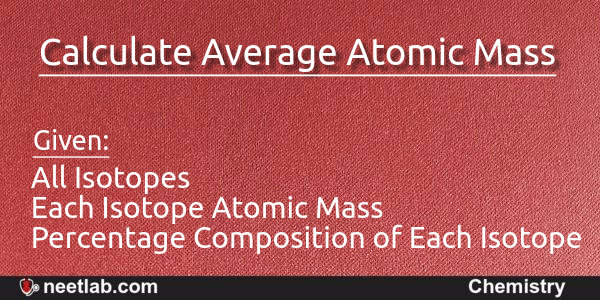
| ⇨ |
What Will Be Given: Isotopes with their abundance and atomic mass
What To Calculate: Average Atomic Mass/Weight
Unit: a.m.u (Atomic Mass Unit)
Explanation :
Average Atomic Mass/Weight is the atomic mass of all the isotopes of the element based on its abundance. All isotopes of an element do not occur naturally in the same proportions. So, the Average Atomic Mass takes into account the distribution of the different isotopes of each element and the atomic mass of each isotope.
[lyte id=”ULRsJYhQmlo” \]
Steps:
- If percentage abundance is not given for one isotope you need to calculate it.
- %abundance of one isotope = 100 – sum of other given isotopes
- Average Atomic Mass =∑(Mass of Isotope x %natural abundance) / 100
Tips and Tricks:
- The problem may be reversed by asking you to calculate percentage abundance by providing other values such as isotope mass and average atomic mass. For elements having two isotopes, you have to use x and 100-x (or 1-x) in the formula for percentage composition of isotope1 and isotope2 respectively.
- If percentage abundance of two out of 3 isotopes is not given, take one isotope abundance as x and represent other isotope abundance as 100-x (in percentage) or 1-x (in numerical). Refer example (3).
Example-1:
| Isotope | Atomic Mass | Abundance |
| Chlorine-35 | 34.96885 amu | 75.53% |
| Chlorine-37 | 36.97790 amu | 24.47 % |
AAM = (34.96885 x 0.7553) + (36.97790 x 0.2447)
=26.41 + 9.048
=35.46 a.m.u
Example – 2
Beanium, a new ‘element,’ has been discovered. Beanium is known to have three naturally occurring stable ‘isotopes.’ A sample of 77 ‘atoms’ of beanium was tested and the following results were obtained:
| Isotope | Number in Sample |
Mass |
| Black | 55 | 10.26 g |
| Brown | 15 | 8.64 g |
| White | 7 | 8.67 g |
Calculate the “atomic weight” of beanium.
Solution:
1) Calculate the percent abundance:
Bl: 55/77 = 0.7143
Br: 15/77 = 0.1948
W: 7/77 = 0.0909
2) Let’s get the masses of one of each bean:
Bl: 10.26 / 55 = 0.1865 g
Br: 8.64 / 15 = 0.5760 g
W: 8.67 / 7 = 1.2386 g
3) The ‘atomic mass’ is a weighted average:
(0.1865) (0.7143) + (0.5760) (0.1948) + (1.2386) (0.0909) = 0.358 g
Example-3:
Oxygen is composed of three isotopes: One has mass of 16.999 amu. This isotope makes up 0.037% of oxygen. Of the other two, one has a mass of 15.995 amu, and the other has a mass of 17.999 amu. Calculate the abundance of the other two isotopes, using the average atomic mass of 15.9994 amu.
Solution:
1) Set abundances (as decimal percents):
O-16: x
O-17: 0.00037
O-18: 0.99963 – xNote that 0.99963 is (1 minus 0.00037)
2) Set up average atomic weight equation:
(15.995) (x) + (16.999) (0.00037) + (17.999) (0.99963 – x) = 15.9994
Solving above, x = 0.9976
3) The percent are as follows:
O-16: 99.76%
O-17: 0.037%
O-18: 0.203%
Related Questions:
- ³⁵₁₇Cl and ³⁷₁₇Cl are two isotopes of chlorine. If average atomic weight is 35.5
- Copper occurs naturally as Cu-63 and Cu-65. Given Atomic Weight
- Boron has two stable isotopes, ¹°B(19%) and ¹¹B(81%). Average atomic weight
Related Concepts:
Topics: Basic Concepts of Chemistry (5)Subject: Chemistry (2512)
Important MCQs Based on Medical Entrance Examinations To Improve Your NEET Score
18000+ students are using NEETLab to improve their score. What about you?
Solve Previous Year MCQs, Mock Tests, Topicwise Practice Tests, Identify Weak Topics, Formula Flash cards and much more is available in NEETLab Android App to improve your NEET score.
Share this page with your friends

Leave a Reply